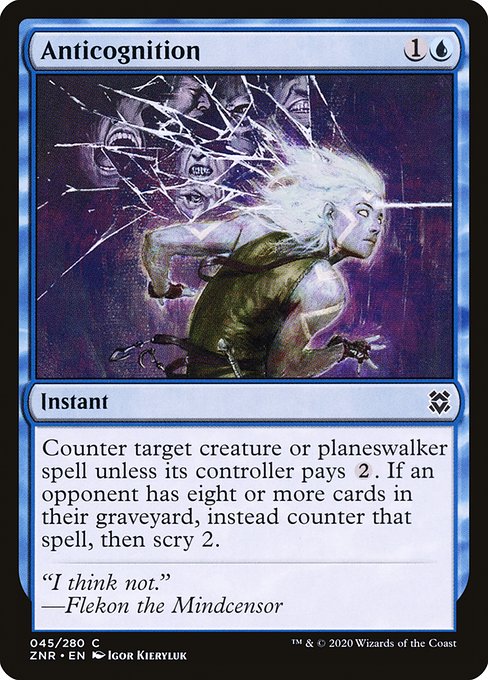
Image courtesy of Scryfall.com
Understanding Tempting Templates: How Card Wording Guides Your Mind on the Fly
In the wild frontier of Magic: The Gathering, templating isn’t just about punctuation—it’s cognitive architecture. When you read an instant like Anticognition from Zendikar Rising, you’re watching a masterclass in how two short lines of text shape how you think, react, and plan your next three draws. This blue spell is a compact example of how designers scaffold understanding: a clean baseline effect, a conditional twist, and a mechanic that nudges you toward smoother decisions as the game unfolds 🧙♂️🔥.
What the card does, in plain language
Anticognition costs {1}{U} and reads: “Counter target creature or planeswalker spell unless its controller pays {2}. If an opponent has eight or more cards in their graveyard, instead counter that spell, then scry 2.” The mana cost places it in the early-to-mid blue tempo/silver bullet lane, while the default effect asks you to weigh a small tax against a built-in denial for a specific type of spell. The second line introduces a powerful conditional twist—if the graveyard has blossomed enough for your opponent, the spell’s outcome flips toward countering, with the bonus of scry 2 to polish your next draws.
- Default outcome: Counter target creature or planeswalker spell unless its controller pays {2}. The player must consider whether paying two mana is worth saving their threat this turn.
- Conditional twist: If an opponent has eight or more cards in their graveyard, the spell is countered instead, then you scry 2. The condition is a pivot that rewards graveyard-centric strategies and punishes inertia in decks that rely on the graveyard being full.
- Targeting nuance: The spell targets a specific category (creature or planeswalker) and then imposes a cost—this is classic blue control, but templating makes the decision flow feel like a conversation rather than a single action.
Templating as a cognitive tool
The line structure demonstrates a powerful teaching principle: provide a clear baseline, then overlay a conditional pathway. The word unless creates a simple risk-reward calculus—will your opponent pay {2}? The kicker instead signals a replacement path under a precise condition, transforming the expected outcome: no longer just a tax; you replace the typical counter with a more aggressive response plus card selection through scry 2. Players quickly learn to scan for keywords—Counter, target, planeswalker, graveyard, scry, and the exact numerical thresholds—because those tokens unlock a chorus of strategic decisions in every game. In other words, templating teaches you to see the rules as a toolset rather than a wall of text 🧙♂️🎲.
Flavor, art, and how they reinforce the template
Flavor text often nudges players to feel the card’s personality beyond its numbers. Anticognition’s flavor line, “I think not.” —Flekon the Mindcensor, hints at a mind-detecting, mind-blocking adversary, which mirrors the card’s defensive stance. Igor Kieryluk’s art channels the cool, weighty vibe of blue mana—calm surface, deep currents— echoing the careful calculation players perform when reading templated text. Zendikar Rising’s set structure, with its adventures and floaty wards of blue, makes this card feel at home in a world where memory and mind are a battleground. And as a common rarity, it’s a reliable entry point for players learning to parse multi-part templating without gilding the path with rarity anxiety 🧊💎.
Impact on learning curves and deck-building
Templating like this isn’t just a parsing exercise—it’s a mental model that translates into deck-building behavior. When you grasp that the graveyard condition can replace the entire effect, you begin to anticipate how opponents will play around your permission and how you can tilt the odds with clever timing. In formats ranging from Pioneer to Modern or even Commander, Anticognition stands as a teaching tool for recognizing when a card’s real power lies not in a single line of text, but in the orchestration of two interacting rules—one that demands a pay, another that reshapes the outcome with a graveyard threshold. The presence of Scry within the template also nudges you toward favorable refiltration of the top deck, aligning tempo with information advantage ⚔️🎨🎲.
“Templated text is a map. The more you read it, the more you see paths your opponents might travel—and the more confident you become about choosing yours.”
For players who love the art, the lore, and the micro-choices that define a match, Anticognition is a small but mighty exemplar of how templating shapes understanding. It’s also a reminder that even in a world of complex rules, clean phrasing and thoughtful layout can turn a two-mana instant into a durable teaching moment. The card proves that you don’t need a flashy high-cost spell to change how players think about the game; you just need clear logic, a touch of destiny, and a well-placed scry to nudge your next draw toward the right answer 🧙♂️🔥.
Speaking of keeping pace with you at the table or on the go, a reliable grip for your phone can make game nights and rule-checks a lot smoother. The following product link is a handy companion for players who stream, draft, or just keep track of rulings while chatting with friends—practical MTG lifestyle meets on-the-go convenience.